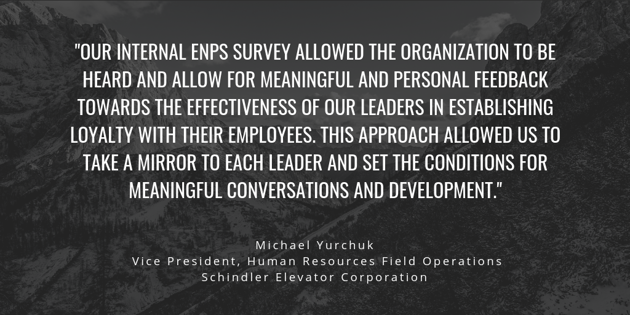Rather than find out how employees feel about working for your company at the water cooler, why not ask directly to the source and ask?
A measurement tool like Employee Net Promoter Score (eNPS) is a simple yet informative way to measure and improve employee loyalty and engagement. The insights the survey uncovers can be used to develop strategies to improve employee loyalty.
What is Employee Net Promoter Score?
Like the traditional Net Promoter Score system, the eNPS survey measures a person’s likelihood to recommend your company as a place to work. It offers insight into the factors impacting the employee experience.
The primary question for eNPS asks, “On a zero-to-10 scale, how likely is it you would recommend (insert your organization name here) as a place to work to a friend or colleague?” A secondary question is, “What are the most important reasons you selected that score?”
The results offer a way to examine employees' feelings about the workplace and their commitment to the organization. Ultimately, they provide actionable intelligence, such as the level of cultural alignment, passion, commitment, and loyalty of your workforce.
Why Does Measuring Employee Satisfaction and Engagement Matter?
When employees are happy, it can pay dividends. Take the example of Southwest Airlines. Here, employees come first, and the airline isn’t shy about putting employee happiness at the forefront.
In 2017, a Forbes article reported that Southwest Airlines would share $586 million in profits with its 54,000 employees—a 13.2% average bonus for each employee, roughly the equivalent of six weeks’ pay.
In the article, CEO Gary Kelly said, “Our people-first approach, which has guided our company since its founding, means that when our company does well, our people do really, really well. Our people work incredibly hard and deserve to share Southwest’s success.”
Employee satisfaction has become an increasingly important business focus as employers realize the direct link between happy employees and their company’s long-term success. That’s because engaged employees have lower turnover and help create loyal customers. Plus, if employees feel good about your company, they’ll be more likely to go above and beyond and actively look for ways to improve the organization.
How Do You Calculate Employee Net Promoter Score?
Now that you recognize how important eNPS is, the next step is understanding how to calculate it. If you’re familiar with the Net Promoter Score methodology, then you know it sorts employees into three categories: Promoters, Passives, and Detractors, based on the rating they gave your company.
“Promoters” score you between a 9 and 10. This group of employees is loyal enthusiasts who are highly engaged and may urge their friends to join the organization, too. “Passives” provide a score between 7 and 8. They are satisfied but unenthusiastic employees who may be susceptible to being recruited by other companies. And “Detractors” hand out scores between zero and 6. This group comprises unhappy employees who some might describe as trapped in a bad relationship.
To calculate your score, take the percentage of Promoters employees and subtract the percentage of Detractors.
Of course, eNPS is much more than a score. Using an unstructured, open-ended question, the survey asks employees the reasons for their ratings. This allows the organization to collect comments from employees—in their own words.
Strategies to Improve your Employee Net Promoter Score
Measuring and understanding the Employee Net Promoter Score offers significant value. It helps leadership confidently address concerns, improve, and fuel the innovations that foster more Promoters. Importantly, it establishes trust with employees when you give them a voice and act on their input. Here are a few ways you can improve your eNPS.
1. Work with senior leaders to set the tone.
Collaboration and teamwork start at the top; everyone must be committed to continuous improvement. Be ready to invest in your culture, training, and recruiting, which will net big rewards.
2. Ensure complete anonymity for those responding to the survey.
Offer employees a “safe” place to provide feedback. Often, working with a third-party company helps. Failure to provide anonymity could lead to employees not providing accurate information for fear of retribution.
3. Provide opportunities for employees to give input.
Cultivate an environment where people are comfortable sharing feedback, such as anonymous employee opinion surveys—and be open and transparent about the results.
4. Take stock of your reputation.
Find out what employees say about you on employer review sites like Glassdoor, Indeed, Comparably, Careerbliss, and Vault. What you discover may be eye-opening.
5. Celebrate and acknowledge employees for going above and beyond.
You don’t have to fly as high as Southwest Airlines. Simply responding to employee feedback and taking appropriate action can go a long way in cultivating workplace satisfaction.
It’s been said that to win in the marketplace, you must first win in the workplace. Measuring the Employee Net Promoter Score opens the door for honest and constructive dialogue between employees and their managers. From there, you can take steps to improve employee opinions, which in turn raises your Employee Net Promoter Score.
Looking for eNPS benchmarking? Read our post on comparing your score to peers.


